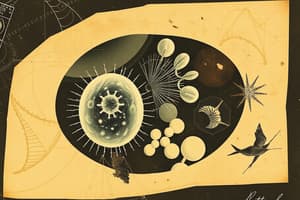Podcast
Questions and Answers
What did Robert Hooke observe in a thin slice of cork?
What did Robert Hooke observe in a thin slice of cork?
Cells
In what year did Robert Hooke make his observation about cells?
In what year did Robert Hooke make his observation about cells?
- 1680
- 1670
- 1665 (correct)
- 1660
What is the Latin word for 'cell'?
What is the Latin word for 'cell'?
Cellula
Cork cells were observed to be unicellular organisms.
Cork cells were observed to be unicellular organisms.
What part of the onion is used to observe cells under a microscope?
What part of the onion is used to observe cells under a microscope?
Chlamydomonas, Paramecium, and _______ are examples of unicellular organisms.
Chlamydomonas, Paramecium, and _______ are examples of unicellular organisms.
What is the purpose of using safranin solution when preparing the onion peel slide?
What is the purpose of using safranin solution when preparing the onion peel slide?
What do multicellular organisms consist of?
What do multicellular organisms consist of?
Flashcards are hidden until you start studying
Study Notes
Discovery of Cells
- Robert Hooke first observed cells in cork using a self-designed microscope in 1665.
- The structure of the cork resembled a honeycomb, consisting of small compartments.
- Hooke coined the term "cells," derived from the Latin word for 'a little room.'
- This observation marked a significant milestone in the history of biological science.
Understanding Cells
- Cells are the fundamental units of life, representing separate units within living organisms.
- Living organisms are made up of cells which can be unicellular or multicellular.
- Unicellular organisms consist of a single cell, such as Chlamydomonas, Paramecium, and bacteria.
- Multicellular organisms are formed from many cells working together to perform different functions.
Preparing and Observing Onion Cells
- A practical activity involves examining the epidermis of an onion bulb under a microscope.
- Peel the inner layer of the onion and transfer it to a slide with a drop of water to avoid drying.
- Use safranin solution to stain the material before covering it with a slip for clear observation.
- Observations reveal that onion cells are similar in structure across different sizes, indicating consistency in multicellular organisms.
Microscopic Observation Tools
- A compound microscope consists of various parts:
- Eyepiece
- Coarse adjustment
- Fine adjustment
- Body tube
- Arm
- Clips
- Stage
- Swivel
- Condenser
- Mirror
Importance of Observation in Biology
- Observing cells under a microscope enhances understanding of cell structures and functions.
- Activities involving the preparation of temporary mounts provide hands-on experience in biology.
- Comparing unicellular and multicellular structures aids in appreciating the complexity of life forms.
Studying That Suits You
Use AI to generate personalized quizzes and flashcards to suit your learning preferences.



